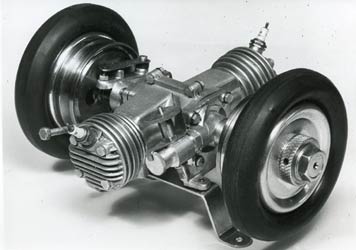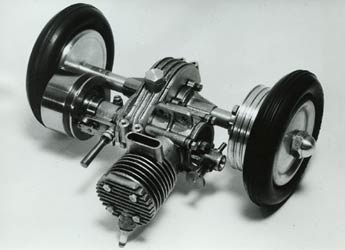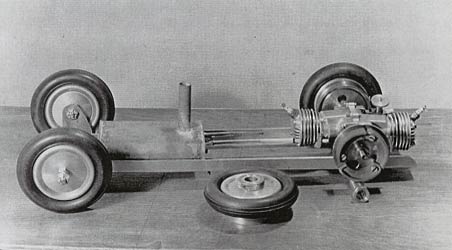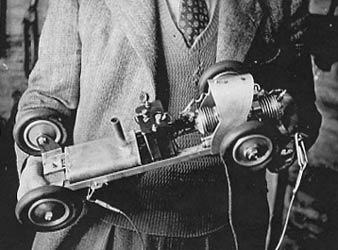

|
Home Updates Hydros Cars Engines Contacts Links Racing Contact On The Wire |
Pitbox Special
Harry Rae and a Craftsman Twin
Of the hundreds of enthusiasts that took up building and running tethered cars in the immediate post war period, most remain anonymous, an unidentifiable face in a photograph or a passing mention in text somewhere. Others became better known, whether for their success on the track, the cars they built or designed or their contribution to the sport. Harry Rae was definitely one of the former, a member of the Dudley Model Car Club who came to our attention through just one engine he made that was featured in an issue of Model Car News. That alone was not enough, but thanks to his son Gordon contacting us in relation to our 1066 research he was able to furnish us with details and photos of his father’s involvement with tethered cars. The final link was two superb photos discovered in the Westbury archive of engines built by Harry Rae, specifically for his cars.
 |
 |
| Unique Craftsman twin | Cadet with integral gearbox |
Harry (Pop) Rae (Henry Allan Watson Rae 1903-1982) was a precision engineer, at one time working successively for Morgan Motors, Ford Motors, Archdales Worc's LTD. Where he became acquainted with John Bishop who provided much of our 1066 material, Flight Refuelling Ltd. and finally the Government establishment of T.R.E. Malvern, now QinetiQ.
|
His son, Gordon introduced him to the world of model racing cars in 1946 with a birthday present of a copy of the D. A. Russell & D. B. M. Wright book, Model Race Cars, which was instrumental in firing up his interest in tethered cars. Gordon was also a ‘life long’ modeller and in those early post war days shared a common interest in two-stroke engine design with his father, through his speed control line flying. Several model engines were constructed the first of which was a 5.8cc Hallam Nipper from a set of castings and materials for the princely sum of 12/6. Harry built both
original designs and Westbury’s, together with a 1066 Falcon from
castings supplied personally by hand from Geoffrey Hastings. As a racing
cyclist Gordon was well suited to the task of providing the motive power
for the 1914 treadle lathe on which the component parts of this and
other engines were machined. Quite large amounts of calories were burnt
during the machining of ‘one piece crankshafts’ from 3 per cent nickel
chrome steel! |
|
To the north of the city of Worcester there was an airfield at Perdiswell, a wartime R.A.F. initial pilot training facility using Tiger Moths. During an exploratory visit to the airfield at the end of the war when all the training activities had ceased, Harry and Gordon discovered a ‘compass circle’ of concrete, and it had in its centre, a small hole! They soon fabricated an expanding base pole on which to attach the cars and successfully run Harry’s 10-cc car, tethered chassis. Several transactions transpired between Harry Rae and Hastings after the latter discovered the activities over the short period when they used the compass circle at Perdiswell. This rather secretive person would drive up to the gate in a car, then when approached would surreptitiously produce components from his pockets in exchange for cash. Mr. Hastings showed only a cursory interest in the car racing activities, usually avoiding most of the conversation on the technical aspects of the hobby. Harry and Gordon both commented ‘that it seemed a rather strange way to conduct a business’.
|
|
They continued on with our own experiments often accompanied by a work colleague Bill Trow of Dudley. Harry and Bill were engineers at Sir Allan Chobham's company - Flight Refuelling Ltd where Gordon also became an aircraft-engineering apprentice. Gordon told us that ‘the three of us often journeyed to "Eaton Bray" model drome to attend the meetings of the British Model Car Club, where like minded enthusiasts would meet and admire the engineering of each others model cars and run them tethered on the concrete circle track. There was no competitive compulsion in those early days, just interest in each other's designs, the desire to admire the running of each other's cars and occasionally to run a speed nomination event, at around 30 m.p.h., all very gentlemanly. Left: Dudley Model Car
Club members line-up in 1947. |
Gordon continues, 'It was the appearance of F.G.Buck with his Gwin Aero 7.5cc engined car that immediately doubled our normal running speeds, this influence and a progressive change of bias in favour of speed, finally dominated contests events, this situation was further augmented by the imported American Dooling cars. It was this development that completely changed the nature of the BMCC whereupon most of the original members, together with our group, quietly faded away’.
At Eaton Bray around 1946/7, a film was made by the Pathe News which was shown to the nation on local cinema screens. This item showed some of the model cars close up and running, and Harry Rae was shown full screen, sitting on the end of a work table looking out on the audience while smoking his pipe! Happily, this film is still available on the Pathe site.
Although, like so many other enthusiasts of the period, Harry and Gordon Rae lost interest in the competitive aspects of the tethered cars but did continue to run them as described by Gordon.
"Our Falcon and Cadet engines were used in one of my first control line model team racing aircraft, (B class up to 5cc) in 1948 and competed successfully in local contests. With my interest in model aircraft, it was at my suggestion that we tried pops 10cc car in one of the local sports fields, with me holding on to the tether line, in control line fashion. The racer was successfully run using this method on several occasions (at possibly 30 m.p.h. max.) and prompted my pop to determine that it would be practical to run the car free of all constraints. And so it was, from that time on we ran the car ‘free running’ in the large, short mowed grass sports field. The car would be set off with just a trace of turn on the front wheels, and of it would go! It would career of in a progressively tightening arc until it would finally spin around, with the centrifugal clutch slipping, and would then set of on another curving trajectory and so on. Its run was terminated either by the flip aerial switch, fuel running out or by ending up in a boundary hedge, still with engine running against the slipping centrifugal clutch.
|
The Craftsman Twin was designed by Edgar Westbury and marketed by Craftsmanship Model of Ipswich. It was not the most functional of motors for a tethered car, although it was a perfectly workable twinshaft if the crankshaft was extended both ends. Harry Rae approached his in an entirely different manner. It would be mounted across the chassis, with the cylinders fore and aft.
A wheel was attached to each side of
the motor, like a twinshaft, but with only one wheel being driven, and this
through a centrifugal clutch, disguised as a brake drum behind the 1066
wheel and tyre. At the other end of the crank was a flywheel with a
groove for a starting cord, whilst the second wheel and tyre was free to
run on an extension to the crankshaft. |
|
A simple chassis from angle, had two 1066 wheels and tyres at the front, rotating on stub axles with a standard 1066 MRC aluminium body shell to finish it all off. Harry described the building of the engine in Model Car News for November 1948 with a photo of the jigs and fixtures he had used in the construction. He concluded by saying that "I hope to be in a position to report some of the results obtained with the car in the near future when it goes on the track". For reasons alluded to above, this does not appear to have happened. The Dudley Model Car Club did not affiliate to the MCA so nothing further was known of Harry Rae or any of the other members.
 |
 |
| Car as photographed for Model Car News | Car as run |
Unfortunately, none of the Rae’s cars still exist, apart from the parts of an early chassis, but Gordon did retain the 1066 Falcon, Craftsman Twin, Cadet and another Westbury design of 10cc together with two of Harry’s original 10cc designs.
As a footnote, Edgar Westbury described the construction of an integral gearbox unit to be mated to one of his 5cc Cadet motors and we believe that the photo of the completed unit used to illustrate the article was also built by Harry Rae, as it features a similar clutch arrangement to the twin in the 1066 wheel.
We are grateful to Gordon Rae for most of the details, text and photos included in the article, and if the name Rae does ring any bells then that is quite possible, as Gordon became involved with building and racing full sized cars under the RAE name. In an interview published in 2010, Gordon revealed that he had taken up racing full sized cars again at the age of 80 as well as publishing a massive volume on vintage speed and team race flying.
©copyrightOTW2018